Think of your living room in the late 90s.
Sunlight on the carpet. You hear a tiny chime, then a purple dinosaur waddles in, arms wide, voice soft. Your room changes. Your day slows. A song about sharing drifts in like a lullaby you can almost touch.
If you grew up with Barney, you can probably hum the tune right now.
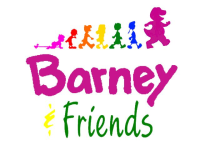
Maybe you remember the clean up song, the marching songs, the goodbye song. Maybe you remember sitting with a sibling who would not sit still for anything else. Parents had opinions, kids did not care. The big purple friend felt safe, simple, and kind.
Barney & Friends began as a small idea that grew into a global preschool hit. It turned everyday places, a classroom, a park, a backyard, into stages for make believe. The lessons were gentle. Please and thank you. Try again. Friends matter. Feelings matter. For many of us, that was the first time TV felt like a hug.
Today, we look back with clear eyes and warm hearts.
We will trace the roots, from home videos to PBS fame. We will meet the kids who starred, and the friends in dino suits who kept the magic going. We will revisit the songs that stuck, the episodes that still glow, and the controversies that followed the fame. We will compare it with other preschool giants, and see what still works today.
Ready to press play on the memory?
Let’s step back into that sunny room, sing along, and see why this simple show still echoes.
The home video series, Barney and the Backyard Gang, caught on with parents and toddlers. Word spread. PBS took notice. In 1992, Barney & Friends launched on public television and turned a friendly idea into a preschool juggernaut.
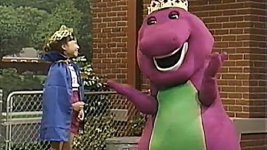
I remember that jump. One day he was a tape your cousin owned. The next, he was on every weekday morning, part of the routine. Breakfast. Backpack. Purple dinosaur.
Behind the suit were makers who believed in soft lessons and simple joy. Writers shaped small kid problems into gentle stories. Songwriters built melodies you could hum in the car. Performers brought the character to life with big body movement and a warm, steady voice. It looked easy. It was not.
Each episode felt like a playdate. A classroom, a playground, a backyard.
A small problem pops up. A friend feels shy. A toy breaks. A plan goes sideways. Then songs, pretend games, a craft or two. The clean up song resets the room. By the goodbye song, feelings are named and the problem feels smaller.
The sets were simple on purpose. Big shapes. Bright colors. Props that begged for imagination. A cardboard rocket could take us to the moon. A picnic blanket could start a story.
The show focused on social skills more than tests.
Share the blocks. Say please. Try again. Ask for help.
Notice how someone else feels. It sounds small. It is not small to a four year old. The songs turned manners into habits. Repetition made the lessons stick.
The series ran for years. Casts rotated.
Side characters arrived, like Baby Bop, BJ, and later Riff. In between seasons, the brand lived on in tapes and live shows. Families lined up for purple plush and sing along releases. If you grew up in the 90s, you saw Barney at home, at the mall, and sometimes in a sold out arena.
Performers moved in big, clear gestures so kids could read emotion from a distance. I think knowing that people gave that effort makes the smile feel real.
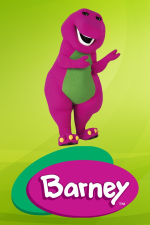
His voice speaks slowly so a child can follow. His movements are big so a small audience can read the emotion from across a room. Design-wise he is bright and simple. The purple, the green belly, the round eyes.
Barney's role is emotional coaching.
He names feelings, models phrases like "I'm sorry" and "Let's try again," and turns mistakes into songs. He is less about facts and more about practice. That makes him closer in spirit to figures like Big Bird on Sesame Street, who also comforts and asks questions, but Barney leans harder on group play and rehearsal.
Where Big Bird often explores the world with childlike curiosity, Barney often steps forward as a calm, coaching presence.
What I liked then and still like now is how intentional Barney is. The suit hides the human, but not the care. The character teaches by example. He is the friendly adult in a costume who invites you to play the lesson into being.
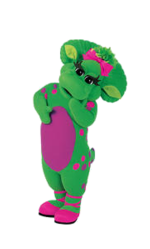
Her voice is higher and more childlike. She trips, giggles, and sometimes needs help. The character exists so young viewers can see the steps of trying, failing, and smiling again.
Her stories focus on first tries; learning to share a toy, standing up in a circle, saying a new word. That tiny scaffold is powerful. Characters like Baby Bop serve a different teaching need than Barney. Where Barney models the adult response, Baby Bop models the child taking the step. That role is common in preschool shows: a character who mirrors toddlerhood so viewers can say, "I can do that too."
In tone she is similar to the littlest characters in shows aimed at toddlers, like the wee Teletubbies figures who respond to sights and sounds. But Baby Bop has clearer language and emotional turns, which makes her a better bridge for kids who are ready for simple speech and social practice.
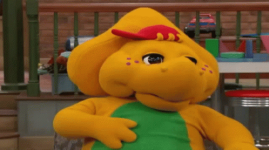
He moves like a big brother who wants to show you a trick. His humor is loud; his heart is soft. He gives the show a different rhythm.
BJ's role is important. He models risk taking and showing off, then learning how to apologize or slow down. That dynamic is a useful foil. Many kids relate to an older sibling figure who both pushes boundaries and helps steady the group.
He is the big kid archetype you see across children's media. He is less a teacher and more a friend who sometimes needs correction. That contrast helps the show cover a wider emotional range in a short episode.
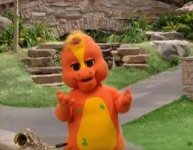
He brings rhythm, new songs, and a bit of tinkering energy. Riff’s bits are full of quick ideas — a beat, a rhyme, a gadget to try. He often pushes the group to experiment: make a drum from a pot, turn a march into a dance, or build a simple toy that leads to a lesson.
What Riff adds is youthful curiosity turned musical. T
hink of him as the show's built in music teacher and inventor rolled into one. He feels similar in spirit to music first characters like those in The Fresh Beat Band, who teach through catchy riffs and movement, or to curious kids in shows like Sid the Science Kid who nudge viewers to ask how things work.
Riff keeps the show from getting too soft; he adds bounce, questions, and small experiments.
They show the small rituals that ease fear, like a hello song, a familiar toy, and a grown up who listens. I remember the way a shy child clutches a backpack, then slowly joins a circle when Barney starts a simple game. The scenes work because they break a big feeling into tiny actions. First we name the worry. Then we try one small step.
Then we celebrate it with a song. Those tiny wins make courage feel possible.
You get a toy tug, a moment of anger, and a calm voice that teaches words instead of hands. The show often uses role play to rehearse a solution. One kid says, "Can I have a turn?" Another suggests a timer or a trade. The music underscores the choice and makes the compromise feel like a team win.
Watching those scenes, I remember how easy it felt to copy the words and try them in the playground.
They are guides for handling big feelings. Jealousy gets named. Excitement gets channelled. Disappointment gets soothed. Barney models how to share attention and include quieter kids. The structure is simple: plan a part, invite feelings, act them out, then close with a comforting song.
Those episodes teach kids that big feelings can be managed and celebrated.
A backyard walk becomes a lesson in bugs, or a puddle becomes a science experiment. Pretend trips; an indoor safari or a cardboard submarine; turn ordinary items into wonder. The show nudges kids to ask questions, name what they see, and try small experiments. That curiosity-first approach still feels useful.
It shows learning as play, not as a test.
The energy in the room flipped the script. Kids sang out, parents recorded, and the stage felt huge. Specials pushed the scale up: more songs, longer stories, costume changes, guest performers. Those events turned a TV character into a memory you could touch.
For many families, the live shows were where the fandom became real.
As an adult I notice staging and craft. The music is clever. The actors work hard. The lessons are simple and focused.
I would watch with a child and point out feelings. I would use the songs for clean up and calm time. I would keep the parts that teach patience and empathy.
Fans said the sweetness was deliberate and useful for small children. I see both sides. For a preschooler, the simple kindness is a useful scaffold. For an older viewer, the endless positivity can feel flat. The real answer sits in the middle: the tone worked for its audience, but it invited pointed jokes once the show left the playroom.
Any long-running show has a behind-the-scenes story.
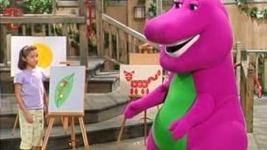
Performers and crew talked about long hours and the physical demands of suits and sets. There were production pressures, tight schedules, and the challenge of keeping kids safe during live events. These are valid concerns to note when we celebrate the show.
The care shown on screen came from a lot of hard, sometimes messy, work off-camera. Some researchers worried that nonstop cheer might leave kids less prepared for frustration.
Others argued that Barney offered a safe place to practice social skills and name feelings. I tend to side with the latter: the show was a rehearsal space. It named feelings and modelled simple coping steps. That skill practice is hard to dismiss, even if the tone stayed sunny.
Barney changed slowly. New characters arrived.
Songs shifted a bit. Production values improved. The show tried to stay relevant without losing its core. Sometimes updates landed well. Sometimes they felt like small course corrections. The willingness to adapt kept the show on air for years, and it shows that the creators listened, at least a little, to changing times.
It shaped tiny habits: saying please, trying again, sharing a toy. Those are small things with big effects. Watch an episode now, and you might notice how gentle practice can stick.
Use the songs. Use the quiet endings. Rewatch with a child or a friend.
Turn nostalgia into a teaching moment. It is okay to laugh at the parodies and still keep the lessons. The show was simple on purpose, and that simplicity helped kids feel safe enough to try.
Barney was not perfect. He was steady.
He offered a rehearsal space for kindness. In a loud world, that steady song still matters. Sing once more. Teach one small habit. Keep the tune going.
What are your memories of Barney & Friends?
Sunlight on the carpet. You hear a tiny chime, then a purple dinosaur waddles in, arms wide, voice soft. Your room changes. Your day slows. A song about sharing drifts in like a lullaby you can almost touch.
If you grew up with Barney, you can probably hum the tune right now.

Maybe you remember the clean up song, the marching songs, the goodbye song. Maybe you remember sitting with a sibling who would not sit still for anything else. Parents had opinions, kids did not care. The big purple friend felt safe, simple, and kind.
Barney & Friends began as a small idea that grew into a global preschool hit. It turned everyday places, a classroom, a park, a backyard, into stages for make believe. The lessons were gentle. Please and thank you. Try again. Friends matter. Feelings matter. For many of us, that was the first time TV felt like a hug.
Today, we look back with clear eyes and warm hearts.
We will trace the roots, from home videos to PBS fame. We will meet the kids who starred, and the friends in dino suits who kept the magic going. We will revisit the songs that stuck, the episodes that still glow, and the controversies that followed the fame. We will compare it with other preschool giants, and see what still works today.
Ready to press play on the memory?
Let’s step back into that sunny room, sing along, and see why this simple show still echoes.
How Barney Began and Grew
Barney did not start on TV. He began in living rooms, on clunky VHS tapes.The home video series, Barney and the Backyard Gang, caught on with parents and toddlers. Word spread. PBS took notice. In 1992, Barney & Friends launched on public television and turned a friendly idea into a preschool juggernaut.

I remember that jump. One day he was a tape your cousin owned. The next, he was on every weekday morning, part of the routine. Breakfast. Backpack. Purple dinosaur.
Behind the suit were makers who believed in soft lessons and simple joy. Writers shaped small kid problems into gentle stories. Songwriters built melodies you could hum in the car. Performers brought the character to life with big body movement and a warm, steady voice. It looked easy. It was not.
Each episode felt like a playdate. A classroom, a playground, a backyard.
A small problem pops up. A friend feels shy. A toy breaks. A plan goes sideways. Then songs, pretend games, a craft or two. The clean up song resets the room. By the goodbye song, feelings are named and the problem feels smaller.
The sets were simple on purpose. Big shapes. Bright colors. Props that begged for imagination. A cardboard rocket could take us to the moon. A picnic blanket could start a story.
The show focused on social skills more than tests.
Share the blocks. Say please. Try again. Ask for help.
Notice how someone else feels. It sounds small. It is not small to a four year old. The songs turned manners into habits. Repetition made the lessons stick.
The series ran for years. Casts rotated.
Side characters arrived, like Baby Bop, BJ, and later Riff. In between seasons, the brand lived on in tapes and live shows. Families lined up for purple plush and sing along releases. If you grew up in the 90s, you saw Barney at home, at the mall, and sometimes in a sold out arena.
What was Behind the Purple Curtain?
1 Inside the suit, heat and choreo
The Barney suit was more than a costume. It was heavy and hot.Performers moved in big, clear gestures so kids could read emotion from a distance. I think knowing that people gave that effort makes the smile feel real.
2 Small sets, big imagination
The studios kept things simple on purpose. A few blocks, a painted tree, a cardboard car. That minimalism pushed kids to fill the gaps. I still admire how a small prop could open a whole world.3 How teachers borrowed the songs
Barney’s music traveled beyond TV. Teachers used the songs in classrooms and day care. Clean up time became a quick sing along. Those classroom echoes helped the lessons move from screen to life.4 The business, toys and tours
Barney was a brand as much as a show. Plush toys, VHS tapes, live sing alongs, school visits. The business kept the purple presence alive between episodes. I remember the mall shows, the kids in the crowd, the sing alongs that felt bigger than the stage.5 Parodies and the bashing era
With fame came jokes. Comedians and late-night shows made fun of the sweetness. The internet later turned that into a culture of parody. Still, the loud jokes never erased why kids loved the show.The Characters of Barney & Friends Show
Barney, the gentle guide
Barney is the show's heart. He is patient, clear, and musical.
His voice speaks slowly so a child can follow. His movements are big so a small audience can read the emotion from across a room. Design-wise he is bright and simple. The purple, the green belly, the round eyes.
Barney's role is emotional coaching.
He names feelings, models phrases like "I'm sorry" and "Let's try again," and turns mistakes into songs. He is less about facts and more about practice. That makes him closer in spirit to figures like Big Bird on Sesame Street, who also comforts and asks questions, but Barney leans harder on group play and rehearsal.
Where Big Bird often explores the world with childlike curiosity, Barney often steps forward as a calm, coaching presence.
What I liked then and still like now is how intentional Barney is. The suit hides the human, but not the care. The character teaches by example. He is the friendly adult in a costume who invites you to play the lesson into being.
Baby Bop, shy and brave
Baby Bop fills the toddler mirror. She is small, green, and carries a comfort blanket.
Her voice is higher and more childlike. She trips, giggles, and sometimes needs help. The character exists so young viewers can see the steps of trying, failing, and smiling again.
Her stories focus on first tries; learning to share a toy, standing up in a circle, saying a new word. That tiny scaffold is powerful. Characters like Baby Bop serve a different teaching need than Barney. Where Barney models the adult response, Baby Bop models the child taking the step. That role is common in preschool shows: a character who mirrors toddlerhood so viewers can say, "I can do that too."
In tone she is similar to the littlest characters in shows aimed at toddlers, like the wee Teletubbies figures who respond to sights and sounds. But Baby Bop has clearer language and emotional turns, which makes her a better bridge for kids who are ready for simple speech and social practice.
BJ, the loud big brother
BJ brings the larger kid energy. He is bouncy, confident, and often a little clumsy.
He moves like a big brother who wants to show you a trick. His humor is loud; his heart is soft. He gives the show a different rhythm.
BJ's role is important. He models risk taking and showing off, then learning how to apologize or slow down. That dynamic is a useful foil. Many kids relate to an older sibling figure who both pushes boundaries and helps steady the group.
He is the big kid archetype you see across children's media. He is less a teacher and more a friend who sometimes needs correction. That contrast helps the show cover a wider emotional range in a short episode.
Riff, music and curiosity
Riff is the orange, perky spark who joined later to freshen the band.
He brings rhythm, new songs, and a bit of tinkering energy. Riff’s bits are full of quick ideas — a beat, a rhyme, a gadget to try. He often pushes the group to experiment: make a drum from a pot, turn a march into a dance, or build a simple toy that leads to a lesson.
What Riff adds is youthful curiosity turned musical. T
hink of him as the show's built in music teacher and inventor rolled into one. He feels similar in spirit to music first characters like those in The Fresh Beat Band, who teach through catchy riffs and movement, or to curious kids in shows like Sid the Science Kid who nudge viewers to ask how things work.
Riff keeps the show from getting too soft; he adds bounce, questions, and small experiments.
5 Best Moments Worth Rewatching
First day courage
Episodes about first days at preschool are gold.They show the small rituals that ease fear, like a hello song, a familiar toy, and a grown up who listens. I remember the way a shy child clutches a backpack, then slowly joins a circle when Barney starts a simple game. The scenes work because they break a big feeling into tiny actions. First we name the worry. Then we try one small step.
Then we celebrate it with a song. Those tiny wins make courage feel possible.
Sharing in practice
Barney turns sharing into a scene, not a lecture.You get a toy tug, a moment of anger, and a calm voice that teaches words instead of hands. The show often uses role play to rehearse a solution. One kid says, "Can I have a turn?" Another suggests a timer or a trade. The music underscores the choice and makes the compromise feel like a team win.
Watching those scenes, I remember how easy it felt to copy the words and try them in the playground.
Birthdays, holidays, big feelings
Party episodes are more than cake and songs.They are guides for handling big feelings. Jealousy gets named. Excitement gets channelled. Disappointment gets soothed. Barney models how to share attention and include quieter kids. The structure is simple: plan a part, invite feelings, act them out, then close with a comforting song.
Those episodes teach kids that big feelings can be managed and celebrated.
Nature walks and pretend trips
Some of my favorite moments are the small excursions.A backyard walk becomes a lesson in bugs, or a puddle becomes a science experiment. Pretend trips; an indoor safari or a cardboard submarine; turn ordinary items into wonder. The show nudges kids to ask questions, name what they see, and try small experiments. That curiosity-first approach still feels useful.
It shows learning as play, not as a test.
Live shows and big specials
Seeing Barney live was louder and sillier than TV.The energy in the room flipped the script. Kids sang out, parents recorded, and the stage felt huge. Specials pushed the scale up: more songs, longer stories, costume changes, guest performers. Those events turned a TV character into a memory you could touch.
For many families, the live shows were where the fandom became real.
Why I Still Love This TV Series
I feel calm and small. The songs sit under the scene like a safety net. It brings a gentle mood fast.As an adult I notice staging and craft. The music is clever. The actors work hard. The lessons are simple and focused.
I would watch with a child and point out feelings. I would use the songs for clean up and calm time. I would keep the parts that teach patience and empathy.
What People Said about Barney back Then
Barney's cheer was a lightning rod. Critics called it saccharine and unrealistic.Fans said the sweetness was deliberate and useful for small children. I see both sides. For a preschooler, the simple kindness is a useful scaffold. For an older viewer, the endless positivity can feel flat. The real answer sits in the middle: the tone worked for its audience, but it invited pointed jokes once the show left the playroom.
Any long-running show has a behind-the-scenes story.

Performers and crew talked about long hours and the physical demands of suits and sets. There were production pressures, tight schedules, and the challenge of keeping kids safe during live events. These are valid concerns to note when we celebrate the show.
The care shown on screen came from a lot of hard, sometimes messy, work off-camera. Some researchers worried that nonstop cheer might leave kids less prepared for frustration.
Others argued that Barney offered a safe place to practice social skills and name feelings. I tend to side with the latter: the show was a rehearsal space. It named feelings and modelled simple coping steps. That skill practice is hard to dismiss, even if the tone stayed sunny.
Barney changed slowly. New characters arrived.
Songs shifted a bit. Production values improved. The show tried to stay relevant without losing its core. Sometimes updates landed well. Sometimes they felt like small course corrections. The willingness to adapt kept the show on air for years, and it shows that the creators listened, at least a little, to changing times.
Final Hush: One Last Sing Along
If Barney made you smile as a kid, that feeling still counts.It shaped tiny habits: saying please, trying again, sharing a toy. Those are small things with big effects. Watch an episode now, and you might notice how gentle practice can stick.
Use the songs. Use the quiet endings. Rewatch with a child or a friend.
Turn nostalgia into a teaching moment. It is okay to laugh at the parodies and still keep the lessons. The show was simple on purpose, and that simplicity helped kids feel safe enough to try.
Barney was not perfect. He was steady.
He offered a rehearsal space for kindness. In a loud world, that steady song still matters. Sing once more. Teach one small habit. Keep the tune going.
What are your memories of Barney & Friends?

